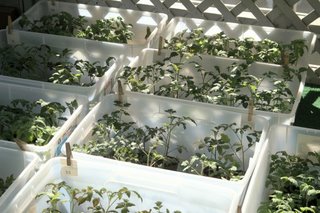Planting tomato plants is fairly easy. It's best not to do it during midday on a sunny day because the full sun tends to be too strong for seedlings to take right away. Try to plant on a cloudy day or in late afternoon. I've planted during full sun and the plants tend to droop pretty quickly. They need to absorb water before the sun hits them with full force.
Water your plants before putting them in the ground. Space tomato seedlings about 2 feet apart in rows 3 feet apart. With a shovel or a trowel, dig your hole. Make it deep enough so that no more than 4 or 5 inches of the plant will be above ground. The more of the plant is above ground, the more it sways in the breeze and the more danger there is of the stem bending or breaking. Loosening the dirt around the future location of the plant is a good idea too, so that the roots have loose soil to dig into rather than packed soil to dig into. If your plant has branches that would be below ground, pinch them off first. If your plant is tall and thin (referred to as "leggy") and you can't dig a hole deep enough to put the plant in vertically, you can dig a horizontal trench, lay the plant down on its side, and GENTLY turn just the top of the plant up so it will be sticking out of the ground. Roots will form all along a buried tomato stem, helping the plant draw in moisture and nutrients.
I use pelleted fertilizer that goes into the hole before I plant, so I don't worry about fertilizing after the plant is in the ground. The brand I use is Osmocote but now Miracle-Gro has also come out with pelleted fertilizer. So if you decide to use these pellets, put those in first according to the directions on the package, swish them around with your trowel or your hand so that they are not all clumped together in one part of the hole, and then put the tomato plant in. As the roots grow they will go down beneath the pellets of fertilizer and every time your plants are watered and the fertilizer dissolves a tiny bit, the pellets will feed the roots little by little.
Once you have put the plant in the hole, fill the rest of the hole with the dirt you got from digging the hole, and pack the soil a little bit around the plant so it will not move when it's watered because loose soil tends to shift when wet. To firm the soil, I use both hands and just give the soil around the seedling a push down into the ground to sort of "set" it. It's hard to describe just how much pressure to use, but use your judgment and don't pound on the darn thing!
If you are worried about cutworms, you need to take some precautions here. A cutworm travels just under the surface of the soil and will chop your seedlings off at the base, much like a lumberjack cuts down a tree. I've had a cutworm chop one of my plants and it's not a pretty sight. To protect against cutworms, all you have to do is to put up some kind of barrier around your seedlings for about an inch into the ground. Cutworms will not dig deeper than that. Some people put a ring of newspaper around their plants, because it's easy, cheap, and the newspaper will decompose eventually. After tomato plants have been in the ground for 2 or 3 weeks, the stems are probably too strong for a cutworm to chew through, so the cutworm protection really only has to last for 2 or 3 weeks.
As cutworm protection I use plastic pots with the bottoms cut out of them. The bottom needs to be removed so the roots can grow down into the soil. I position the cut-out pot so that about an inch is below ground and about an inch or two is above ground. The added benefit to this type of cutworm protection is that the top of the pot makes a nice funnel when watering. I water from the bottom, meaning I water the soil and not the leaves. That's a story for another day... When watering from the bottom, not only do I water around the cut-out pot but I make sure to fill the funnel a couple of times and I know the roots will get watered well. And these cut-out pots are reusable year after year.

I scoop out a "bowl" around my plants so that when I water the water pools up near the plant and is sure to go down to where the roots are. It does no good to water 2 feet away from the roots! Then you're just watering weeds. Later, when mulch is applied (that's for another posting) the bowls remain uncovered.
After planting, water right away to settle the dirt and to give the plant enough moisture to withstand the elements.




